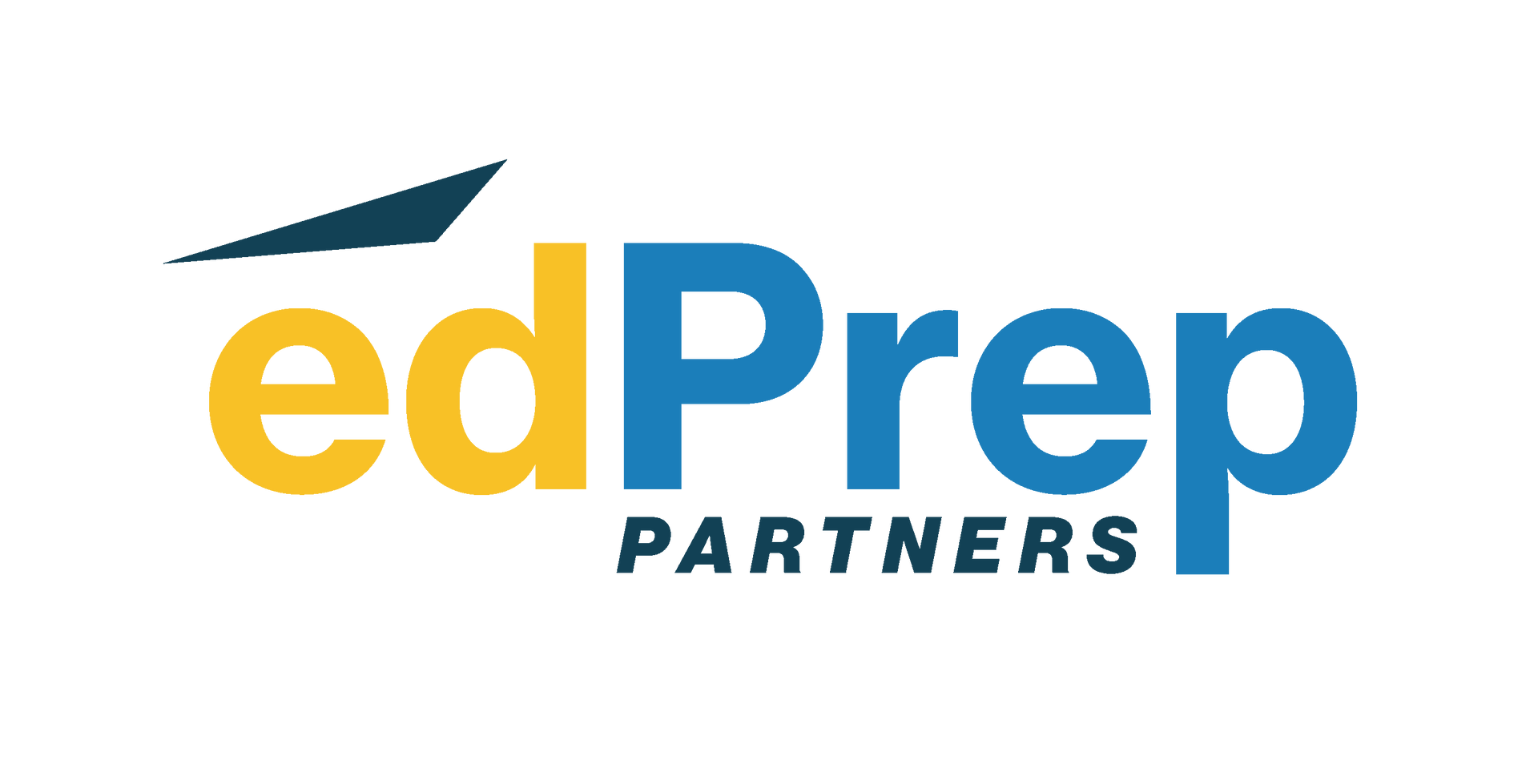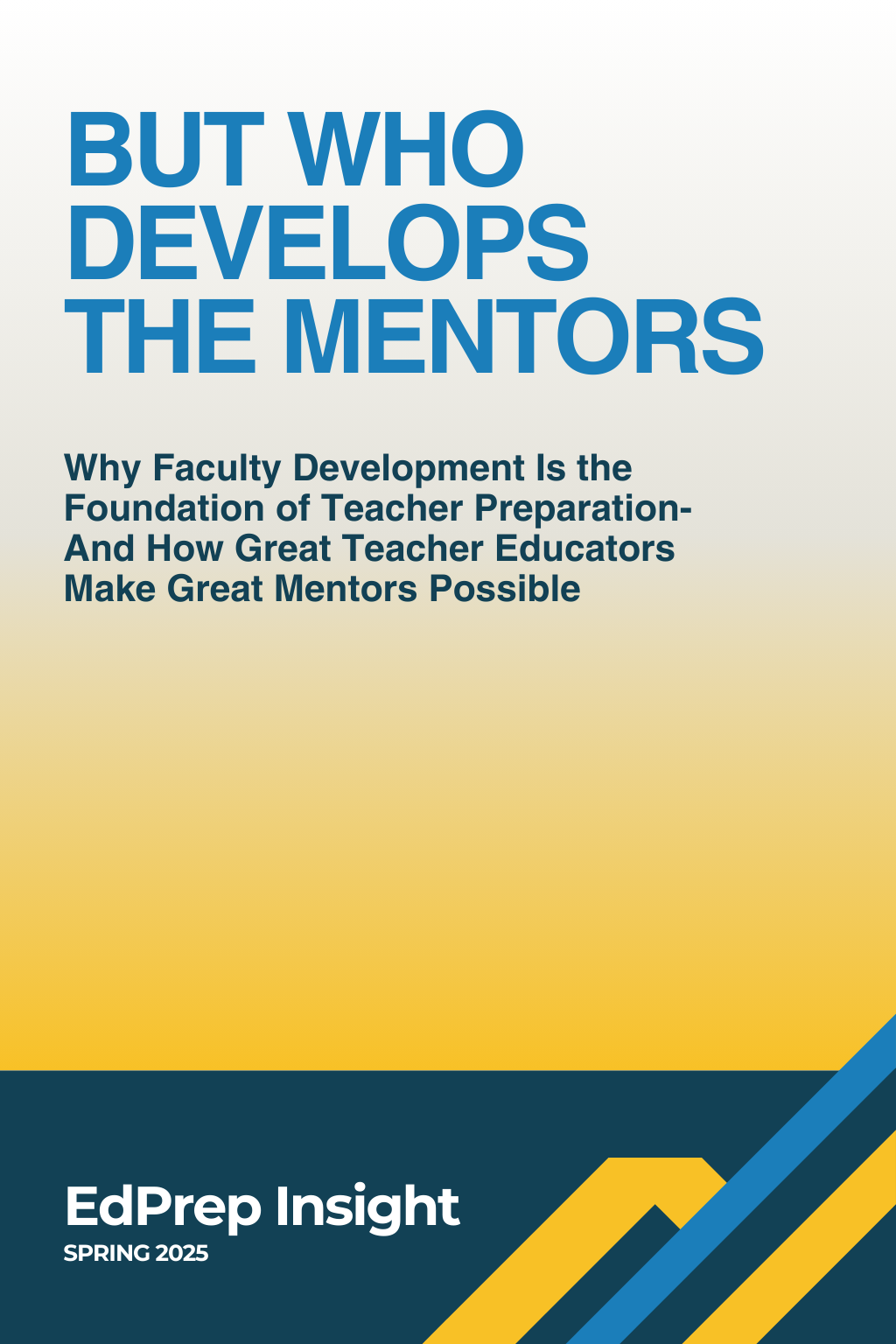But Who Develops the Mentors?
But Who Develops the Mentors?
Why Faculty Development Is the Foundation of Teacher Preparation-And How Great Teacher Educators Make Great Mentors Possible
The Missing Link in Mentor Development
We’ve spent a lot of time lately talking about the people mentoring apprentices and residents in the field—and rightly so. This latest New America report has sparked renewed attention to a long-overlooked truth: in K–12 apprenticeship, pre-service, and sometimes in-service models, mentor teachers are the backbone of teacher preparation. They model instruction, guide day-to-day practice, and offer the kind of real-time feedback that, in the best-case scenario, accelerates candidate growth. But we can’t “hope” candidates learn how to teach. And we can’t keep overlooking a key group in the process: the faculty and staff inside educator preparation programs.
And that raises a question the field doesn’t ask often enough, though one that actually matters most to the developmental outcomes of a teacher candidate:
Who’s developing the mentors?
In educator preparation, we’ve come to expect that in-service teachers can take on an ever-growing set of responsibilities—coaching, modeling, and providing developmental feedback—often without access to deep, structured, and resourced support. Because they spend the most time with candidates, operate closest to the realities of P–12 classrooms, and often form the most meaningful relationships, mentors are seen as “high-leverage.” As a result, we’ve too often placed the bulk of candidate development on mentors and P–12 schools’ shoulders.
At the same time, we’ve accepted a pair of quiet assumptions:
- First: That the people responsible for supporting mentors—EPP directors, faculty, and supervisors—already know how to effectively model instruction, coach mentors, and deliver high-quality feedback. That they don’t need structured development themselves.
- Second: That the EPP teacher educators have already equipped mentors with the tools, training, and support needed to develop teacher candidates well.
Faculty and supervisors within educator preparation programs are the developers of mentors. And they need tools, routines, and ongoing development just as much as anyone else in the system. In fact, they need it most. Their role isn’t just to support candidates, but to develop the teacher educators who do.
When faculty aren’t equipped to design developmental experiences, lead effective coaching and rehearsal cycles, or provide feedback aligned to shared expectations, research-backed methods, and defined instructional criteria, mentoring breaks down—even with the best intentions in place.
Faculty development isn’t optional or periodic, it’s the foundation of scalable, high-quality teacher preparation. As Francesca Forzani of TeachingWorks reminds us, “As teacher educators, no one should take instruction more seriously than we do.”
The Conditions That Shape Mentoring
In too many educator preparation programs, mentoring is treated as a standalone function—isolated from the faculty, coursework, and routines that define a candidates’ preparation experiences more broadly and deeply (meaning, where the time and resources in preparation are spent (coursework, clinical experiences and observation cycles, etc.). Mentors are expected to model high-quality instruction, guide novice practice, and give actionable feedback. But what do we imagine happens when the people designing those experiences haven’t been supported to do that work themselves?
Mentorship doesn’t operate in a vacuum. It reflects what faculty and field supervisors prioritize, plan for, and model. Strong mentoring depends on strong teacher educators, including those who can translate instructional frameworks into rehearsal and feedback routines, scaffold development across time, and consistently model what high-quality teaching looks like. To do that well, they must be equipped with clear performance criteria and the capacity to offer focused, developmental feedback.
And yet, in too many places:
- There’s often no shared definition of high-quality teacher educator practice. No clear criteria, performance expectations, or consistent observation and feedback structures like the ones we expect for candidates. Frameworks and practices, like those from TeachingWorks, offer strong starting points to embed within faculty development.
- Observation and feedback tools vary widely, or don’t exist at all. This gap extends beyond coaching protocols and includes uneven or missing use of instructional frameworks, which serve as the shared foundation for candidate development and performance expectations.
- Faculty often receive little to no structured development on how to label, model, teach, or coach toward proficiency in key methods, instructional pedagogies, content pedagogies, or instructional strategies.
These gaps aren’t incidental, they’re structural. And they directly impact the candidate experience. When faculty aren’t prepared to develop mentors, mentors can’t fully develop candidates. And the entire system suffers from a lack of clarity, consistency, and support.
How Strong Programs Develop Better Mentors
Strong mentoring doesn’t start in the P–12 classroom. It begins with the people and practices that develop effective mentors. The strategies that make mentoring effective—modeling instruction, defining clear expectations, using structured coaching routines, and providing actionable feedback—aren’t just for mentors. They’re core responsibilities of the faculty, supervisors, and program leaders who design, support, and sustain high-quality teacher preparation.
When teacher educators are equipped to model, label, and coach instructional practice themselves, they’re better positioned to develop mentors who can do the same. And when expectations are aligned across coursework and clinical experiences, candidates experience more consistent and connected support.
Strong programs invest in the people and structures that make effective mentoring possible. Mentoring systems don’t improve by chance. They improve through clear expectations, shared language, and deliberate, supported practice—starting with the people who lead them.
Five things strong programs do to ensure faculty, supervisors, and mentors are all set up to succeed:
- Establish Clear Criteria for Instructional Practices
Strong programs don’t leave quality teaching to interpretation. They ensure teacher educators can articulate, teach, and apply clear criteria for what proficient performance looks like, grounded in the instructional methods and pedagogies the program prioritizes. Candidates know what’s expected. Mentors and faculty know how to support it. - Label & Model High-Quality Instructional Practices
Faculty, supervisors, and mentors consistently label & model prioritized instructional methods and pedagogies—not just in coursework, but across rehearsals, field-based debriefs, and candidate coaching. They explicitly label the criteria of effective teaching and connect them to the program’s instructional framework, reinforcing shared language and clear expectations. - Use Structured Coaching and Feedback Routines
Strong programs don’t leave coaching to chance, they rely on repeatable, structured routines when engaging with candidates in their development. These include clear observation protocols, intentional debrief planning that prioritizes the highest-leverage growth area(s), and focused feedback conversations that incorporate labeling, modeling, and rehearsal. Next steps are actionable, aligned to each candidate’s developmental trajectory, and anchored in the instructional performance criteria defined by the program and P–12 partners. - Deliver Feedback That Builds Proficiency Over Time
Effective feedback is specific, timely, actionable, developmentally appropriate, and aligned to shared expectations. It meets candidates where they are—and builds toward where they need to be—by supporting the knowledge, skills, and practices required for more advanced methods, pedagogies, and the needs of P–12 students. Faculty and supervisors provide both oral and written feedback that reinforces common instructional language, supports growth over time, and builds toward instructional proficiency. Crucially, feedback is calibrated across raters—ensuring it is fair, focused, and consistent. - Align Expectations Between Faculty and Mentors
Strong programs ensure that faculty, supervisors, and mentor teachers operate from a shared understanding of instructional expectations and feedback language. This alignment doesn’t happen by chance—it requires intentional faculty development, structured calibration routines, and shared tools that anchor conversations in the program’s instructional framework. When expectations are aligned, candidates receive clearer, more consistent support across coursework and clinical practice.
These five practices aren’t just features of building strong mentoring programs, they’re the habits of strong programs. When faculty and supervisors do these things consistently, mentoring becomes a system, not a guess. Expectations are clearer. Support is more focused. And candidates are better prepared to teach.
Programs don’t need to overhaul everything to improve faculty practices—and, in turn, mentor practices. Strong programs start small. They choose and consistently apply a common instructional framework. They identify core instructional methods, along with the definitions and criteria that guide candidate development within them. They select one or two high-leverage teacher educator practices that all faculty, supervisors, and mentors will use to support candidates. They adopt a focused coaching structure and process—such as Jim Knight’s Impact Cycle, Elena Aguilar’s Transformational Coaching Cycle, or Paul Bambrick-Santoyo’s “See It, Name It, Do It” model—and align all feedback to the instructional framework and method criteria. From there, they progress monitor and ensure teacher educators are prepared to support mentors with the same clarity, consistency, and intentionality we expect mentors to show candidates.
Where Quality Mentoring Begins
Strong mentoring doesn’t happen by accident, and neither does strong teacher preparation. It happens by design. Programs that cultivate strong mentors understand that quality mentoring stems from strong modeling, clear expectations, and consistent support upstream. And that means attending to the development of the people who make it all possible: the faculty, supervisors, and staff inside educator preparation programs.
If mentors deserve support, modeling, and clarity, then the same must be true for those preparing them. These teacher educators do not just contribute to the preparation system—they shape the conditions, habits, and practices that drive it. They influence how mentors understand quality, how feedback is delivered, and how candidates make meaning of what it means to teach well.
At EdPrep Partners, we work alongside programs to build that foundation, helping faculty and supervisors define what high quality practice looks like, model it with intention, and build the tools and routines to help others do the same. Our work supports not just individual development, but system level clarity and alignment, so that every candidate benefits from all teacher educators.
Because when all teacher educators grow, candidates grow. And when candidates grow, so do P–12 students.
Let’s make teacher preparation better—together.
Calvin J. Stocker
Founder & CEO, EdPrep Partners
Stay Connected
If you're interested in learning more, exploring collaboration or technical assistance, or just want to catch up, we’d love to connect:
About EdPrep Partners
Elevating Teacher Preparation. Accelerating Change.
EdPrep Partners is a national technical assistance center and non-profit. EdPrep Partners delivers a coordinated, high-impact, hands-on technical assistance model that connects diagnostics with the support to make the changes. Our approach moves beyond surface-level recommendations, embedding research-backed, scalable, and sustainable practices that most dramatically improve the quality of educator preparation—while equipping educator preparation programs, districts, state agencies, and funders with the tools and insights needed to drive systemic, lasting change.



